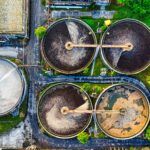Smog, beyond that dense fog
Smog is a mixture of air pollutantsAir pollution caused by atmospheric contaminants is one of the most critical and complex environmental problems we face today, both because of its global r...
Read more that accumulate in the atmosphere, especially in urban areas. This phenomenon is characterised by the formation of a dense layer of pollution whose appearance is between smoke and fog (from which comes its name “smog”) that reduces visibility and significantly affects air qualityAir quality refers to the state of the air we breathe and its composition in terms of pollutants present in the atmosphere. It is considered good when poll...
Read more. But how does it form and why is it so harmful?
Not all types of air pollution are smog. Smog does, however, include pollutants that alter air quality. They come mainly from emissions from fossil fuel-powered vehicles, industries and other combustion sources whose emissions into the atmosphere react with each other chemically activated by sunlight.
In addition to the harmful effects on human health, such as respiratory problems, eye irritation and aggravation of cardiovascular diseases, smog has a significant impact on the environment. It can damage crops by decreasing their productivity or destroying forests, alter biodiversity and contribute to climate change.
Cities with high levels of smog often experience a decrease in the quality of life of their inhabitants, which underlines the importance of taking measures to reduce air pollution.
At Kunak Technologies, we have innovative solutions to monitor and reduce these impacts, thanks to sensors capable of measuring and monitoring in time the main gases that contribute to smog formation.
Air Quality Innovation in Just 1 Click
Stay informed about the air you breathe!
Subscribe to our newsletter to receive the latest updates on environmental monitoring technology, air quality studies, and more.
How is smog formed?
Smog is an atmospheric pollution phenomenon that originates mainly in large cities. It is formed when certain pollutants in the air react chemically under the influence of sunlight. This process is more common on sunny and hot days, when solar radiation is more intense.
The main actors in the formation of smog are ozone (the main smog-forming gas), nitrogen oxides, carbon monoxide and particulate matter. These pollutants come mainly from emissions from vehicles, factories and other industrial activities. When these compounds are released into the air, they interact with sunlight and undergo a series of complex chemical reactions.
During these reactions, secondary pollutants or atmospheric immissionsAn atmospheric immission is the concentration of a pollutant detected in the atmosphere whose presence modifies the natural composition of the air. Its ori...
Read more are generated, such as tropospheric or ground-level ozone, which is a key component of smog. Ozone is a gas that is notoriously harmful to human health, causing respiratory problems and other ailments. Tropospheric ozone, although colourless and odorless, even at low concentrations, is capable of causing eye, mucous membrane and respiratory tract irritation.
How does smog affect our health?
When inhaled, smog has a devastating effect on human health, causing respiratory problems, exacerbating diseases such as asthma, emphysema and bronchitis, and increasing respiratory infections.
It also increases the risk of cardiovascular disease. Recent studies suggest a link between exposure to inhaled ozone and an increased risk of heart attack and stroke.
It is particularly dangerous for sensitive populations such as children and the elderly. It also has a direct effect on lung infections, the development of lung cancer and an increase in premature mortality.
Prolonged exposure to pollutants such as tropospheric ozone and particulate matter can lead to serious complications, particularly in vulnerable people, affecting their quality of life and general wellbeing.
Factors such as humidity and poor air circulation also play an important role in the formation of smog. High humidity can accelerate chemical reactions, while the absence of wind hinders the dispersion of pollutants, increasing their concentration in the air and the likelihood that they will combine to form smog.
How does smog affect the environment?
In addition to health effects, smog also damages the environment. Air pollutants contribute to the acidification of soil and water, affecting local flora and fauna. Reduced visibility and deterioration of ecosystems are direct consequences of pollution, underlining the urgent need for sustainable measures to protect our planet.
Smog not only pollutes the air, but also our future. Let’s act now to breathe cleaner tomorrow.
How many types of smog are there?
There are two types of smog:
Photochemical smog
This is a form of air pollution that is mainly observed in cities with heavy traffic. It manifests itself as a yellowish-brown haze. This type of smog is produced when emissions into the atmosphere, such as nitrogen oxides (NOx) and volatile organic compounds (VOCs), react with sunlight, generating atmospheric immissions such as ground-level ozone.
Industrial smog
Also known as sulphur smog, this is a form of air pollution that occurs in areas with a high concentration of industry. This type of smog is characterised by the presence of suspended particles, such as soot and heavy metals, as well as toxic gases such as sulphur dioxide (SO2) and nitrogen dioxide (NO2).
What makes up smog?
Among the most common and harmful pollutants present in the atmosphere that contribute to the formation of smog are:
Sulphur dioxide (SO2)
Sulphur dioxide is a colorless, toxic gas that can cause respiratory problems and aggravate diseases such as asthma.
Nitrogen oxides (NOx)
Nitrogen oxides are toxic gases that contribute to the formation of tropospheric ozone and fine particulate matter, both key components of smog.
Volatile Organic Compounds (VOCs)
Volatile organic compounds are major chemicals in photochemical smog. When combined with nitrogen oxides under sunlight, they form ground-level ozone.
Particulate Matter (PM)Atmospheric particulate matter are microscopic elements suspended in the air, consisting of solid and liquid substances. They have a wide range of sizes an...
Read more
Particulate matter are tiny particles that float in the air and can penetrate deep into lung tissue and from there reach the bloodstream causing serious health problems, including cardiovascular disease, respiratory disease and cancer.
Tropospheric Ozone (O3)
Ground-level ozone can have a significant impact on our health. This pollutant not only affects respiratory and cardiovascular functions, but can also lead to increased hospitalizations, absences from work and school, increased use of medications and even premature mortality.
Short-term exposure to ozone can cause respiratory damage by reducing lung function and causing inflammation in the airways. In the long term, continued exposure can aggravate respiratory diseases such as asthma and increase the risk of stroke.

Why is smog so bad – Kunak
Main causes of smog
Vehicle emissions
Cars and heavy vehicles powered by fossil fuels are the main emitters of the pollutants that combine to form smog. When fuels such as gasoline and diesel are burned, nitrogen oxides and volatile organic compounds are released into the air. These are the pollutants that react with sunlight, creating ground-level ozone.
Industrial activity
Industries and their manufacturing processes are a source of emissions of pollutants such as sulphur dioxide and particulate matter that contribute to smog formation.
Inadequate waste management
The burning of waste emits nitrogen oxides, volatile organic compounds and particulate matter. Their decomposition emits greenhouse gasesWhile the concentration of carbon dioxide (CO2) in the atmosphere has been steadily and rapidly increasing in recent decades, in May 2025, CO2 surpassed 43...
Read more that contribute to global warming, which in turn increases the formation of smog. Some wastes emit harmful gases into the air as they decompose, which contribute to photochemical smog.
Burning fossil fuels
Apart from mobility with combustion vehicles, power generation and heating by burning coal, oil and natural gas also release pollutants into the air that contribute to smog formation.
Climatic conditions
Weather plays a crucial role in smog formation. Days of higher solar intensity, as occurs in the summer, and poor air circulation facilitate the accumulation of pollutants in the atmosphere, while rain and wind can help disperse them.
Anti-smog solutions
Reducing vehicle emissions
One of the main sources of photochemical smog is vehicle emissions. To combat them, it is essential to promote sustainable mobility through the use of electric vehicles and improvements in public transport. In addition, implementing low-emission zones in urban areas can significantly reduce the amount of pollutants in the air.
Walking not only benefits our health by improving fitness and reducing stress, but also contributes to reducing smog by reducing the number of vehicles on the road. Keeping private vehicles in good condition and having them serviced is essential to minimise their environmental impact and ensure that they pollute as little as possible.
Controlling industrial emissions
Industries are responsible for being the source of much of the sulphur smog. The installation of filters and pollutant capture technologies in industrial chimneys can reduce the emission of sulphur and nitrogen oxides. In addition, the transition to cleaner energy sources, such as solar, wind and green hydrogen, can reduce industrial dependence on fossil fuels.
Environmental regulations and policies
Governments play a crucial role in the fight against smog. Implementing strict regulations on vehicle and industrial emissions, along with policies that encourage the use of renewable energy, can have a significant impact. Air quality monitoringControlling air quality is an essential task in order to enjoy optimal environmental conditions for healthy human development and to keep the environment i...
Read more regulations and public awareness campaigns are also essential to keep the population informed and engaged.
Reforestation and green spaces
Planting trees in degraded areas and caring for forests, as well as expanding and creating new urban green spaces such as parks and gardens, help to improve air quality. Trees act as natural filters, absorbing pollutants such as particulate matter and carbon dioxide, and release oxygen. In addition, green spaces provide an environment that welcomes greater biodiversity and makes the city more livable for residents, improving their mental and physical health.
Recycling
Recycling is essential to minimise waste and protect our planet. By recycling materials such as paper, plastic and glass, we not only reduce the amount of waste in landfills, but also conserve natural resources and energy. This practice reduces pollution and greenhouse gas emissions, promoting a circular and sustainable economy.





